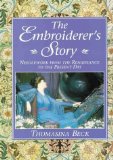|
These embroiderers (formerly part of the tailors, seamstresses, & sewing tools linkspage) show both embroidery both as a profession and as a pastime. Note the evolution in tools used to stretch the fabric to be worked. See also Stitches in Time: Medieval Embroidery in its Social Setting.
There's another page on 18th century embroiderers elsewhere on this site.
- Three queens spinning, weaving, and embroidering, Avis aus Roys (PML M.456, fol. 56r), c. 1340-1360
- Bezalel and Oholiab make a tabernacle for the Ark of the Covenant with ten curtains (fol. 15v) and make holy garments for Aaron (fol. 16r), The Paduan Bible Picture Book (British Library MS Add. 15277), fourth quarter of the 14th century
- Mary embroidering (or weaving?), a book of hours (BNF NAL 3229, fol. 71v), c. 1440-1450
- The Holy Family, a book of hours from Spain (British Library Add. 18193, fol. 48v) made after 1461
- A lady embroiders near a window by the garden, Livre des Prouffis Champestres et Ruraux (PML M.232, fol. 157r), c. 1470
- Needleworkers in the Triumph of Minerva frescoes by Francesco del Cossa at Palazzo Schifanoia, c. 1476-1484
- Drawing of a tapestry with ladies in an enclosed garden, one of whom is embroidering (Gough Drawings Gaignières 16, fol. 58)
- Detail from the Vie Seigneuriale: Embroidery tapestry, c. 1520
- An embroiderer and demonstrations of different methods of transferring patterns to fabric in Paganino’s Il Burato, 1527
- The Silk-Embroiderer, Das Ständebuch, 1568
- Cornelia, mother of the Gracchi, with female companions engaged in needlework by Johannes Stradanus, c. 1580-1605
- A woman embroiders in the background of the portrait of Gabrielle d’Estrées and her Her Sister, the Duchess of Villars, c. 1594
- Frontispiece of Johann Siebmacher's Schön Neues Modelbuch, 1597
- Ladies in a garden embroidering, Album Amicorum of Gervasius Fabricius (British Library MS Add. 17025, fol. 50), c. 1603
- Jacob Leupoltt, Landauer Hausbuch (Amb. 279.2, fol. 94v), 1625
- Alexander Hohlfelder, Mendel Hausbuch (Amb. 317b.2, fol. 103r), 1626
- A personification of Industry in the frontispiece of John Taylor’s The Needles Excellency, 1631
- The Young Virgin by Francisco de Zurbarán, c. 1632-1633; also see Christ and the Virgin in the House at Nazareth (c. 1640) and Childhood of the Virgin (1658-1660)
- The embroiderers by Guido Reni
- A woman embroidering by Abraham Bosse
Thanks to Jerusha for the suggestions for additional links!
|


